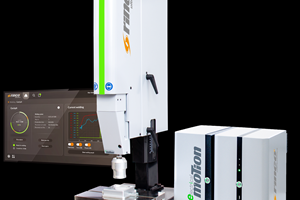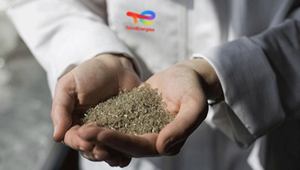Rigid Packaging Goes Lighter, Thinner With Microcellular Foam
Molding higher volumes of a rigid thin-wall part typically means going to a larger press for increased injection and clamping capacity.
Molding higher volumes of a rigid thin-wall part typically means going to a larger press for increased injection and clamping capacity. But one of Europe’s leading packaging producers is accomplishing this feat on smaller presses by taking thin-wall rigid packaging to new lows of lightweighting.
Autobar Packaging Group in Lyon, France, developed Super Light Injection Molding (SLIM), a thin-wall molding concept that for the first time applies the MuCell microcellular foaming process to a packaging application. Autobar combines SLIM with extra-thin, five-sided in-mold labels (IML) that it also developed.
Autobar is a $508-million/yr packaging molder with three divisions (rigid, flexible, and international) operating 15 plants with 2200 employees in seven European countries.
At the rigid packaging plant in Ravensburg, Germany, a directive to increase output of its core product prompted a revolutionary process development, says Eric Chavent, group commercial director at Ravensburg. The main product there is a 150-mm, 500-g PP margarine tub produced in 4+4 stack molds on 550-ton presses. It is the company’s highest-volume rigid packaging item. “We wanted to transfer molding of this part to 385-ton presses for cost savings,” says Thierry Bernet, managing director.
Autobar has 385-ton and 550-ton Netstal injection presses at the plant. A group of 550-ton presses makes 150 million of these 500-g containers a year at the plant and Autobar is looking to raise output to 200 million units annually without buying new machines. Lightweighting the container with SLIM was pivotal to achieving its goals.
Thinner, lighter
The key to SLIM is the MuCell process from Trexel Inc., Woburn, Mass., in which a non-flammable gas is heated and pressurized to a supercritical state so that it behaves like a fluid. Then it is blended with molten resin and injected into the mold. MuCell reportedly can reduce melt viscosity up to 60%, pare process temperatures up to 140° F, decrease molding pressures by 50%, cut clamp-tonnage requirements up to 75%, and reduce or eliminate the need for hold time and hold pressure.
Autobar conducted tests of its SLIM process on a 550-ton press and saw immediate results. Clamp-force and injection-pressure requirements dropped by 15%, to well within the capacity range of a 385-ton press, says Bernet.
Without MuCell, the molded tub weighed 15.21 g and parts exhibited a standard deviation of 0.33 g. With MuCell, part weight dropped 6.5% to 14.23 g and the standard deviation shrank to 0.17 g. MuCell also allowed trimming the wall thickness by 0.4 mm while reducing the chance for sink marks or short shots. “Top-load strength was lowered 15% with the use of MuCell, but it still met performance requirements,” says Bernet.
Autobar developed the 38-micron, five-layer extruded PP label for the tubs at its AFDP facility in Angouleme, France, in collaboration with film supplier Treofan, based in Raunheim, Germany. Typical in-mold labels are 75 microns thick, although some savvy molders are handling 50-micron labels. “Such thin labels enable us to get perfect sealing with lower temperature and injection pressure,” says Bernet.
Autobar will begin molding the thinner tubs on 15 SLIM-ready presses equipped with an IML automation system from Machines Pages SA of Foncine Le Haut, France; label static-charging bars from Simco Co. Industrial Static Control, Hatfield, Pa.; and two-face stack tools from Plastisud SA of Castelnaudary, France. A nitrogen generator from Trexel will service all the MuCell-ready machines.
Related Content
Automation in Thermoforming on the Rise
Equipment suppliers’ latest innovations exemplify this trend driven by factors such as labor shortages, higher-speed thermoformers and tighter quality control.
Read MoreNOVA’s BOPE-HD Film Resin Gains in Globally Available Flexible Food Packaging Applications
Positioned as a recyclable packaging alternative to traditional BOPET films, BOPE-HD film is now available from companies such as Inteplast, JK Materials, Oben Group, and Polivouga.
Read MoreNext-Generation Fully Electric Ultrasonic Welding System
NPE 2024: Rinco new eMotion servo-driven machine is available in 20 kHZ and 35 kHz frequencies.
Read MoreS&B Selected as Contractor for New Hope Energy Advanced Plastics Recycling Unit
New Hope Energy and Total Energies collaboration for an advanced plastics recycling unit gains momentum.
Read MoreRead Next
Lead the Conversation, Change the Conversation
Coverage of single-use plastics can be both misleading and demoralizing. Here are 10 tips for changing the perception of the plastics industry at your company and in your community.
Read MoreProcessor Turns to AI to Help Keep Machines Humming
At captive processor McConkey, a new generation of artificial intelligence models, highlighted by ChatGPT, is helping it wade through the shortage of skilled labor and keep its production lines churning out good parts.
Read MoreWhy (and What) You Need to Dry
Other than polyolefins, almost every other polymer exhibits some level of polarity and therefore can absorb a certain amount of moisture from the atmosphere. Here’s a look at some of these materials, and what needs to be done to dry them.
Read More

























